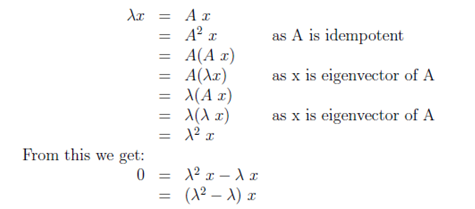SKEDSOFT
Idempotent Matrices:
In ordinary algebra the familiar number whose square is itself are: 0 and 1. Any integer power of 1 is 1. In matrix algebra, the identity matrix I plays the role of the number 1 and I certainly have the property In = I. There are other non null matrices which are not identity and yet have this property namely A2 = A. Hence a new name "idempotent" is needed to describe them. For example the hat matrix is defined as 
 means that
means that  matrix is idempotent . Verify that
matrix is idempotent . Verify that  for any integer power n. If eigenvalues are
for any integer power n. If eigenvalues are  the relation
the relation  means that
means that  Since the only number whose nth power is itself are unity and zero. it is plausible that the eigenvalue of an idempotent matrix are 0 and1.
Since the only number whose nth power is itself are unity and zero. it is plausible that the eigenvalue of an idempotent matrix are 0 and1.
Recall that the rank of matrix equals the number of nonzero eigenvalue and that the trace of matrix is the sum of eigenvalue. Using these two results it is clear that for idempotent matrices that G whose eigenvalue are 0 and 1 we have the interresting relation trace (G) = rank (G).
Problems-1: A matrix A is idempotent if A2 = A. Show that the only possible eigenvalue of an idempotent matrix are λ = 0 and λ = 1. Then give an example of amatrix that is idempotent and has both of these two values are eigenvalues.
Solutions: Suppose that λ is an eigenvalue of A. Then there is an eigenvector x such that Ax = λx. we have

Since x is an eigenvector it is non zero, we get the conclusion that λ2 - λ = 0 and the solution to the quadratic polynomials equation for λ are λ = 0 and λ = 1. The matrix,

is idempotent and since it is a doagonal matrix, its eigen value are the diagonal entries λ = 0 and λ = 1. So each of these possible value for the eigen value of an idempotent matrix actually occurs as an eigenvalue of some idempotent matrix.